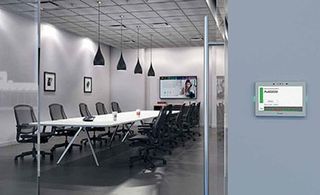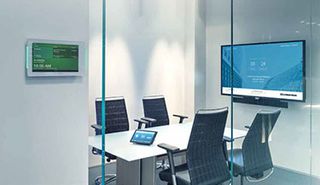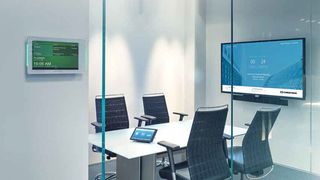It’s all about data: companies today are collecting and applying it in increasingly complex ways to analyze their business and extract as much performance as possible from their operations. But, in the midst of all this digging, people often overlook the simple and obvious solution that’s right in front of them—or, in this case, all around them. Implementing a smart and centralized way of managing workplace utilization is one of the easiest and most profound steps a company can take to boost its productivity—and reduce a lot of frustration in the process.

Extron Room Scheduling directly connects touchpanels stationed outside of rooms to widely used organizational platforms, such as Microsoft Exchange, Office 365, and Google Calendar.
“In today’s business environments, meeting rooms are in high demand, and finding an available room can be a time-consuming experience,” said Joe da Silva, director of product marketing at Extron Electronics. The company’s solution to this issue, Extron Room Scheduling, directly connects touchpanels stationed outside of rooms to widely used organizational platforms, such as Microsoft Exchange, Office 365, and Google Calendar, to provide what da Silva calls a “standalone” room booking solution capable of handling enterprises of any size.

Harman’s Acendo Book allows users to locate and book an available room on the fly from an in-wall touchpanel, and features color codes to make a room’s status recognizable from a distance.
A frequent occurrence is the impromptu meeting, and Harman’s Acendo Book allows users to locate and book an available room on the fly from an in-wall touchpanel, or locate the nearest available room. “This helps eliminate interruptions caused from double-booking a meeting space and allows participants to book rooms on the go,” said David Glaubke, director of public relations at Harman Professional Solutions. “Color coding LEDs let users know at a glance whether a room is booked (red) or free (green). Less time spent scrambling to find a meeting space translates to increased productivity.”

Visionect’s JOAN line of battery-powered, networked meeting room scheduling solutions that utilize an e-ink display like those of e-reader tablets and are designed to be simple to install and integrate.
Traditionally, someone at an organization would need to be tasked with planning and overseeing the booking of rooms throughout an enterprise. “Keeping track of meeting room availability across an office, building, campus, or venue is all too often a complete and utter nuisance; it eats up man hours and resources,” said Urša Primožič, communications manager at Visionect. A newer player in the category, Visionect manufacturers the JOAN line of battery-powered, networked meeting room scheduling solutions that utilize an e-ink display like those of e-reader tablets. “JOAN eliminates the need for the venue operator to replace room availability notices one by one, with the employees updating conference room statuses from the comfort of their laptops or smartphones, or even on the spot.”
One specific kind of status that’s important is the ability to know when a room’s available because no one showed up for a scheduled meeting—if no one’s there, there’s no one to tell you it’s empty. Evoko, a Swedish company with U.S. headquarters outside of Philadelphia, is among the companies that have considered this, and has implemented a “check in” function to its door-side product, so everyone in an enterprise can know if a previously scheduled meeting space has become vacant. According to Rick Castro, head of U.S. operations at Evoko Unlimited, the solution “eliminates interruptions, double bookings, confusion, and ‘ghost meetings,’ ensuring all your meeting rooms are being used in a truly effective and efficient way.”

Crestron’s Enterprise Room Scheduling platform looks to change the way institutions manage their real estate with a variety of customizable tools that not only help with booking space, but also track room and device usage.
Since all of these solutions are network connected, they generate data—and by using this data, companies can gain tremendous insight into how their spaces are utilized. “In today’s workplace, time is valuable and organizations are devoted to finding a solution that eliminates inconsistencies and increases the workflow throughout the enterprise,” said Jeff Singer, executive director of product marketing for Crestron Electronics. Crestron’s Enterprise Room Scheduling platform looks to change the way institutions manage their real estate with a variety of customizable tools that not only help with booking space, but also track room and device usage. “Organizations can also utilize the data to optimize investments in people, spaces, and technology,” Singer said. So you can know not only if a particular room never gets used, but how often, for example, employees use a digital whiteboard in a certain huddle space.
Picking a Platform
So it’s a no-brainer that you should be offering some sort of room scheduling solution to clients. But how do you go about choosing which one is best? “It is vital that the integrator understands the end user’s language, current calendar system, and is aware of the various types of meeting spaces within the facility,” Singer said. “By acquiring this information the integrator will be able to implement a system that is seamless and intuitive. Thus, providing end users an organized and user-friendly solution that they can easily recognize and navigate.”
Evoko’s Castro offered a series of questions to pose, beginning with “How are you currently managing your meeting space?” After getting a picture of the systems a company already has in place, you can begin querying their desired functionality: Do you want visual room status? Check in? Analytics? Reporting of broken equipment? These can help paint a picture of how much capability a company needs—and will actually use—and can prevent over-specifying. Extron’s da Silva expanded on these questions with specifics, such as the desired size of the touchpanels, what kind of information a company would like displayed on them, and whether or not multi-language support is needed.
Glaubke from Harman stressed the importance of determining how the scheduling solution will fit with the enterprise’s other platforms. “Consider whether the product has direct integration with popular email clients without requirement of other system software/hardware,” he said. Another consideration is whether a company is only looking for a room-booking solution, or part of a much larger platform. “Understand if the products are a closed system, or if they offer the ability to extend functionality, such as with Acendo Core and its Netlinx control integration to create even more immersive experiences,” he said.
In developing the JOAN solution, Visionect employed an Early Adopter Program to garner insight into user needs and usage patterns. “It was their input which shaped the device’s functionality and features,” Primožič said. Ultimately, though, the main line of inquiry must boil down to the simple “What is it you truly need?” For the market JOAN addresses, the answer is typically “Not very much.”
“The best way, we find, is to keep things as simple as you can,” Primožič said. “With JOAN you don’t need any additional signage software or complex integrations; the solution fits a company’s scheduling software seamlessly, integrating with the existing calendar. JOAN supports G Suite (Google Apps, Google Calendar), Office 365, Microsoft Exchange 2010+ (Outlook), and iCalendar (.ics).”
This wide compatibility is shared by Crestron’s platform: “This allows integrators to design a seamless solution that is consistent, familiar, and transparent,” Singer said. Da Silva added that it’s also vital that users can access the system from any device, especially given the rise in BYOD. “Scheduling software should be platform agnostic, offering users the ability to book a room from a PC or a mobile device such as a laptop or smartphone,” he said. “The best software interface would be one that offers a consistent experience from one device type to another.”
As companies shift their philosophies to embrace collaboration and construct facilities with open floor plans, the premium on private meeting spaces has perhaps never been higher. Now is the time to help these firms integrate a platform that not only helps them make the most of their real estate today, but equips them with the analytics to develop even more efficient workplaces in the future.
Matt Pruznick is senior editor of SCN and Residential Systems. Follow him on Twitter @Pruznick.


